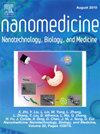Constructing a blood contact material surface with selective adhesion of multiple cells using TiO2 photocatalytic oxidation of polydopamine
IF 4.6
2区 医学
Q2 MEDICINE, RESEARCH & EXPERIMENTAL
Nanomedicine : nanotechnology, biology, and medicine
Pub Date : 2025-04-01
DOI:10.1016/j.nano.2025.102815
引用次数: 0
Abstract
The effective measure to promoting endothelial repair is to construct a surface similar to that of normal vascular on blood contact materials. The construction of cell culture platform regulating platelets, endothelial cells (ECs) and Smooth muscle cells (SMCs) may provide more help to promote endothelial repair. In this work, a novel versatile cell research platform UV-P-PDA@TiO2 was constructed by magnetron sputtering and photoetching. The surface of UV-P-PDA@TiO2 was evaluated by materials science methods such as FTIR, Raman, Micro BCA and WCA, and cell culture was performed on the surface. These results indicated that UV-P-PDA@TiO2 platform regulated the cellular behavior of platelets, ECs, and SMCs, achieved selective adhesion, and exhibited orientation. The advantage of histocompatibility was demonstrated by in vivo tests that UV-P-PDA@TiO2 had pattern stability and inhibited tissue proliferation. Conceivably, the regulating the multicellular UV-P-PDA @ TiO2 culture platform may provide a versatile surface engineering strategy for biomaterials.

利用TiO2光催化氧化聚多巴胺构建多细胞选择性粘附的血液接触材料表面
促进血管内皮修复的有效措施是在血液接触材料上构建与正常血管相似的表面。构建调节血小板、内皮细胞(ECs)和平滑肌细胞(SMCs)的细胞培养平台可能对促进内皮细胞修复提供更多帮助。本文利用磁控溅射和光蚀刻技术构建了一种新型的多功能细胞研究平台UV-P-PDA@TiO2。通过FTIR、Raman、Micro BCA、WCA等材料科学方法对UV-P-PDA@TiO2表面进行评价,并在表面进行细胞培养。这些结果表明UV-P-PDA@TiO2平台调节血小板、内皮细胞和SMCs的细胞行为,实现选择性粘附,并表现出定向。组织相容性的优势通过体内试验证明UV-P-PDA@TiO2具有模式稳定性和抑制组织增殖。可以想象,调节多细胞UV-P-PDA @ TiO2培养平台可能为生物材料提供一种通用的表面工程策略。
本文章由计算机程序翻译,如有差异,请以英文原文为准。
求助全文
约1分钟内获得全文
求助全文
来源期刊
CiteScore
11.10
自引率
0.00%
发文量
133
审稿时长
42 days
期刊介绍:
The mission of Nanomedicine: Nanotechnology, Biology, and Medicine (Nanomedicine: NBM) is to promote the emerging interdisciplinary field of nanomedicine.
Nanomedicine: NBM is an international, peer-reviewed journal presenting novel, significant, and interdisciplinary theoretical and experimental results related to nanoscience and nanotechnology in the life and health sciences. Content includes basic, translational, and clinical research addressing diagnosis, treatment, monitoring, prediction, and prevention of diseases.

 求助内容:
求助内容: 应助结果提醒方式:
应助结果提醒方式:


